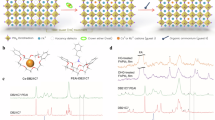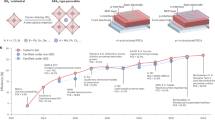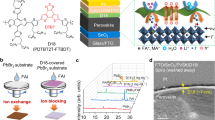Abstract
An important challenge in the commercialization of perovskite solar cells (PSCs) is the simultaneous attainment of high power conversion efficiency (PCE) and high stability. Using polymer interfaces in PSCs can enhance durability by blocking water and oxygen and by suppressing ion interdiffusion, but their electronic shielding poses a challenge for efficient and stable PSCs1,2,3. Here we report a magnetic endohedral metallofullerene Nd@C82–polymer coupling layer, which features ultrafast electron extraction and in situ encapsulation, thereby promoting homogeneous electron extraction and suppressing ion interdiffusion. The Nd@C82–polymer coupling layer in PSCs exhibited a PCE of 26.78% (certified 26.29%) and 23.08% with an aperture area of 0.08 cm2 and 16 cm2 (modules), respectively. The unencapsulated devices retained about 82% of the initial PCE after 2,500 h of continuous 1-sun maximum power point operation at 65 °C.
This is a preview of subscription content, access via your institution
Access options
Access Nature and 54 other Nature Portfolio journals
Get Nature+, our best-value online-access subscription
27,99 € / 30 days
cancel any time
Subscribe to this journal
Receive 51 print issues and online access
199,00 € per year
only 3,90 € per issue
Buy this article
- Purchase on SpringerLink
- Instant access to full article PDF
Prices may be subject to local taxes which are calculated during checkout




Similar content being viewed by others
Data availability
All data are available in the main text or supplementary materials. The data that support the findings of this study are available from the corresponding authors upon reasonable request. Source data are provided with this paper.
References
Peng, J. et al. Nanoscale localized contacts for high fill factors in polymer-passivated perovskite solar cells. Science 371, 390–395 (2021).
Peng, J. et al. Centimetre-scale perovskite solar cells with fill factors of more than 86 per cent. Nature 601, 573–578 (2022).
Zhao, Y. et al. A polymer scaffold for self-healing perovskite solar cells. Nat. Commun. 7, 10228 (2016).
Chen, H. et al. Improved charge extraction in inverted perovskite solar cells with dual-site-binding ligands. Science 384, 189–193 (2024).
Liu, C. et al. Bimolecularly passivated interface enables efficient and stable inverted perovskite solar cells. Science 382, 810–815 (2023).
Yoo, J. J. et al. Efficient perovskite solar cells via improved carrier management. Nature 590, 587–593 (2021).
Liu, S. et al. Buried interface molecular hybrid for inverted perovskite solar cells. Nature 632, 536–542 (2024).
Zhang, S. et al. Minimizing buried interfacial defects for efficient inverted perovskite solar cells. Science 380, 404–409 (2023).
Yu, S. et al. Homogenized NiOx nanoparticles for improved hole transport in inverted perovskite solar cells. Science 382, 1399–1404 (2023).
Shen, Z. et al. Efficient and stable perovskite solar cells with regulated depletion region. Nat. Photon. 18, 450–457 (2024).
Tang, H. et al. Reinforcing self-assembly of hole transport molecules for stable inverted perovskite solar cells. Science 383, 1236–1240 (2024).
Park, S. M. et al. Low-loss contacts on textured substrates for inverted perovskite solar cells. Nature 624, 289–294 (2023).
Chen, P. et al. Multifunctional ytterbium oxide buffer for perovskite solar cells. Nature 625, 516–522 (2024).
Han, T.-H. et al. Perovskite-polymer composite cross-linker approach for highly-stable and efficient perovskite solar cells. Nat. Commun. 10, 520 (2019).
Jiang, Y. et al. Reduction of lead leakage from damaged lead halide perovskite solar modules using self-healing polymer-based encapsulation. Nat. Energy 4, 585–593 (2019).
Luo, J. et al. Polymer-acid-metal quasi-ohmic contact for stable perovskite solar cells beyond a 20,000-hour extrapolated lifetime. Nat. Commun. 15, 2002 (2024).
Said, A. A. et al. Sublimed C60 for efficient and repeatable perovskite-based solar cells. Nat. Commun. 15, 708 (2024).
Chen, J. et al. Efficient tin-based perovskite solar cells with trans-isomeric fulleropyrrolidine additives. Nat. Photon. 18, 464–470 (2024).
Ren, X. et al. Mobile iodides capture for highly photolysis- and reverse-bias-stable perovskite solar cells. Nat. Mater. 23, 810–817 (2024).
Li, Z. et al. Stabilized hole-selective layer for high-performance inverted p-i-n perovskite solar cells. Science 382, 284–289 (2023).
Xu, J. et al. Anion optimization for bifunctional surface passivation in perovskite solar cells. Nat. Mater. 22, 1507–1514 (2023).
Khenkin, M. V. et al. Consensus statement for stability assessment and reporting for perovskite photovoltaics based on ISOS procedures. Nat. Energy 5, 35–49 (2020).
Lin, N. et al. STM investigation of metal endohedral fullerene adsorbed on a Van der Waals surface. Phys. Lett. A 222, 190–194 (1996).
Akiyama, K. et al. Absorption spectra of metallofullerenes M@C82 of lanthanoids. J. Phys. Chem. A 104, 7224–7226 (2000).
Zhang, Y. et al. Favorite orientation of the carbon cage and a unique two-dimensional-layered packing model in the cocrystals of Nd@C82(I,II) isomers with decapyrrylcorannulene. Inorg. Chem. 60, 1462–1471 (2021).
Wu, B.-S. et al. Radiation-processed perovskite solar cells with fullerene-enhanced performance and stability. Cell Reports Phys. Sci. 2, 100646 (2021).
Naaman, R. et al. New perspective on electron transfer through molecules. J. Phys. Chem. Lett. 13, 11753–11759 (2022).
Ding, J., Lin, N., Weng, L.-T., Cue, N. & Yang, S. Isolation and characterization of a new metallofullerene Nd@C82. Chem. Phys. Lett. 261, 92–97 (1996).
Jang, Y. W. et al. Intact 2D/3D halide junction perovskite solar cells via solid-phase in-plane growth. Nat. Energy 6, 63–71 (2021).
Kresse, G. et al. From ultrasoft pseudopotentials to the projector augmented-wave method. Phys. Rev. B 59, 1758–1775 (1999).
Olthof, S. et al. Ultralow doping in organic semiconductors: evidence of trap filling. Phys. Rev. Lett. 109, 176601 (2012).
Gong, Y. et al. Boosting exciton mobility approaching Mott-Ioffe-Regel limit in Ruddlesden−Popper perovskites by anchoring the organic cation. Nat. Commun. 15, 1893 (2024).
Zhang, H. et al. Lead immobilization for environmentally sustainable perovskite solar cells. Nature 617, 687–695 (2023).
Ding, B. et al. Dopant-additive synergism enhances perovskite solar modules. Nature 628, 299–305 (2024).
Zhao, Y. et al. Perovskite seeding growth of formamidinium-lead-iodide-based perovskites for efficient and stable solar cells. Nat. Commun. 9, 1607 (2018).
Huang, Z. et al. Anion–π interactions suppress phase impurities in FAPbI3 solar cells. Nature 623, 531–537 (2023).
Chen, Y. et al. Molecular design and morphology control towards efficient polymer solar cells processed using non-aromatic and non-chlorinated solvents. Adv. Mater. 26, 2744–2749 (2014).
Kirchartz, T. et al. Efficiency limits of organic bulk heterojunction solar cells. J. Phys. Chem. C 113, 17958–17966 (2009).
Jiang, Q. et al. Surface reaction for efficient and stable inverted perovskite solar cells. Nature 611, 278–283 (2022).
Sun, H. et al. Scalable solution-processed hybrid electron transport layers for efficient all-perovskite tandem solar modules. Adv. Mater. 36, 2308706 (2024).
Yang, W. et al. Tailoring component incorporation for homogenized perovskite solar cells. Sci. Bull. 69, 2555–2564 (2024).
Lin, R. et al. All-perovskite tandem solar cells with 3D/3D bilayer perovskite heterojunction. Nature 620, 994–1000 (2023).
Kresse, G. et al. Efficiency of ab-initio total energy calculations for metals and semiconductors using a plane-wave basis set. Comput. Mater. Sci. 6, 15–50 (1996).
Kresse, G. Efficient iterative schemes for ab initio total-energy calculations using a plane-wave basis set. Phys. Rev. B 50, 17953–17979 (1994).
Perdew, J. P. et al. Generalized gradient approximation made simple. Phys. Rev. Lett. 77, 3865–3868 (1996).
Dalpian, G. M., Zhao, X,-G., Kazmerski, L. & Zunger, A. Formation and composition-dependent properties of alloys of cubic halide perovskites. Chem. Mater. 31, 2497–2506 (2019).
Blöchl, P. E. Projector augmented-wave method. Phys. Rev. B 50, 17953–17979 (1994).
Grimme, S., Ehrlich, S. & Goerigk, L. Effect of the damping function in dispersion corrected density functional theory. J. Comput. Chem. 32, 1456–1465 (2011).
Grimme, S., Antony, J., Ehrlich, S. & Krieg, H. A consistent and accurate ab initio parametrization of density functional dispersion correction (DFT-D) for the 94 elements H-Pu. J. Chem. Phys. 132, 154104 (2010).
Frisch, M. J. et al. Gaussian 09 Revision D.01 (Gaussian, 2009).
Chen, X. et al. Lanthanides with unusually low oxidation states in the PrB3– and PrB4– boride clusters. Inorg. Chem. 58, 411–418 (2019).
Pantazis, D. A., & Neese, F. All-electron scalar relativistic basis sets for the lanthanides. J. Chem. Theory Comput. 5, 2229–2238 (2009).
Acknowledgements
S.Y. and C.L. thank the Core Facilities Sharing Platform of Xi’an Jiaotong University (XJTU) for performing various characterizations; Y.L. and C.L. thank the staff from the BL02U beamline of the Shanghai Synchrotron Radiation Facility (SSRF) for assistance during data collection. We thank Y. Liang, H. Guo and Y. Zhang at the Instrument Analysis Center of Xi’an Jiaotong University for their assistance with TOF-SIMS, KPFM and HR-TEM analyses, respectively. We also thank the National Key Research and Development Program of China (2024YFE0201800), the National Natural Science Foundation of China (62304111, 22201227, 12274337, U1866203, 92066207, 62175268, 52472199), the Shaanxi Fundamental Science Research Project for Mathematics and Physics (22JSY015, 23JSY005), the Young Talent Fund of Xi’an Association for Science and Technology (959202313020), the Shaanxi Province science and technology activities for overseas students selected funding project (2023015), the State Key Laboratory for Strength and Vibration of Mechanical Structures (SV2023-KF-18), the youth project in natural science and engineering technology (2023SYJ15), the Project of State Key Laboratory of Organic Electronics and Information Displays, the Qin Chuang Yuan Program of Shaan Xi Province (grant no. 2021QCYRC4-37), the Nanjing University of Posts and Telecommunications (GZR2023010046), the Natural Science Research Start-up Foundation of Recruiting Talents of Nanjing University of Posts and Telecommunications (NY223053), the China Fundamental Research Funds for the Central Universities, the China Postdoctoral Science Foundation (grant no. 2022M721026), the Joint Fund of Provincial Science, and Technology Research and Development Plan of Henan Province (Grant No. 232301420004), the Science and Technology Development Fund, Macao SAR (file no. 0010/2022/AMJ, 0060/2023/RIA1, 006/2022/ALC, 0122/2024/AMJ), the research fund of UM (file no. MYRG-GRG2023-00065-IAPME-UMDF).
Author information
Authors and Affiliations
Contributions
W.C., T.Y., M.L., S.Y. and C.L. conceptualized the study; Y.L., Z.L., S.L., T. Liu, W.M., Y.S. and C.L. devised the methodology; Y.L., Z.L., S.L., Y.S., W.Z., Z.Z., J.Z., W.Y., H.G., J.X., D.W., F.D., A.Z., J.L., H.C., B.W., N.Z., H.W., X.L., T. Li, C.K., D.Z., S.C. and Z.Y. conducted the investigation; Y.L., S.L., Y.S. and W.Y. performed the visualization; S.Y., M.L. and C.L. helped with funding acquisition; W.C., S.Y., M.L. and C.L. helped with the project administration; G.X., S.Y., T.Y., W.C., M.L., W.H., and C.L. supervised the study; Y.L. and C.L. wrote the original draft; G.F., L.E., G.X., W.C., T.Y., S.Y., M.L. and C.L. wrote, reviewed and edited the paper. All authors discussed the results and commented on the paper.
Corresponding authors
Ethics declarations
Competing interests
The authors declare no competing interests.
Peer review
Peer review information
Nature thanks Ana Montero-Alejo, Jae Yun and the other, anonymous, reviewer(s) for their contribution to the peer review of this work.
Additional information
Publisher’s note Springer Nature remains neutral with regard to jurisdictional claims in published maps and institutional affiliations.
Supplementary information
Supplementary Materials
Supplementary Notes 1–13, Supplementary Figs. 1–53, Supplementary Tables 1–10 and Supplementary References.
Source data
Rights and permissions
Springer Nature or its licensor (e.g. a society or other partner) holds exclusive rights to this article under a publishing agreement with the author(s) or other rightsholder(s); author self-archiving of the accepted manuscript version of this article is solely governed by the terms of such publishing agreement and applicable law.
About this article
Cite this article
Lin, Y., Lin, Z., Lv, S. et al. A Nd@C82–polymer interface for efficient and stable perovskite solar cells. Nature 642, 78–84 (2025). https://doi.org/10.1038/s41586-025-08961-9
Received:
Accepted:
Published:
Issue Date:
DOI: https://doi.org/10.1038/s41586-025-08961-9



